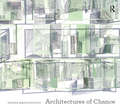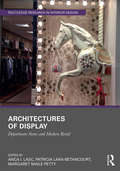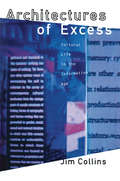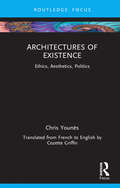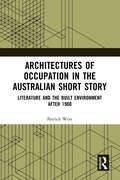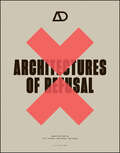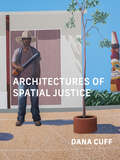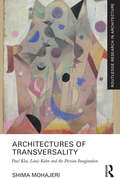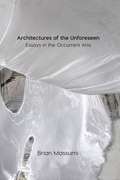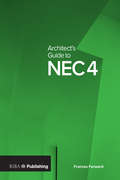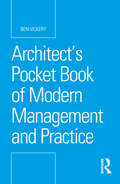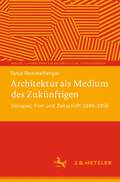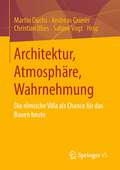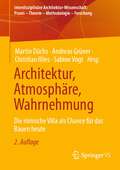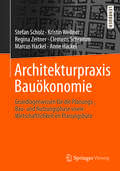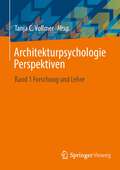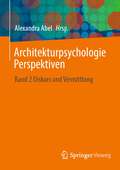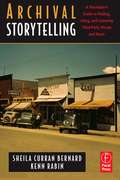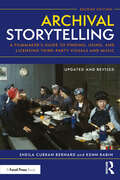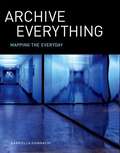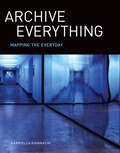- Table View
- List View
Architectures of Chance (Design Research in Architecture)
by Yeoryia ManolopoulouArchitectural discourse and practice are dominated by a false dichotomy between design and chance, and governed by the belief that the architect’s role is to defend against the indeterminate. In Architectures of Chance Yeoryia Manolopoulou challenges this position, arguing for the need to develop a more creative understanding of chance as aesthetic experience and critical method, and as a design practice in its own right. Examining the role of experimental chance across film, psychoanalysis, philosophy, fine art and performance, this is the first book to comprehensively discuss the idea of chance in architecture and bring a rich array of innovative practices of chance to the attention of architects. Wide-ranging and through a symbiotic interplay of drawing and text, Architectures of Chance makes illuminating reading for those interested in the process and experience of design, and the poetics and ethics of chance and space in the overlapping fields of architecture and the aleatoric arts.
Architectures of Display: Department Stores and Modern Retail (Routledge Research in Interior Design)
by Anca I. Lasc Patricia Lara-Betancourt Margaret Maile PettyThrough an international range of case studies from the 1870s to the present, this volume analyzes strategies of display in department stores and modern retail spaces. Established scholars and emerging researchers working within a range of disciplinary contexts and historiographical traditions shed light on what constitutes modern retail and the ways in which interior designers, architects, and artists have built or transformed their practice in response to the commercial context.
Architectures of Excess: Cultural Life in the Information Age
by Jim CollinsFirst Published in 1995. Much of recent theory has characterized life in media-sophisticated societies in terms of a semiotic overload which, allegedly, has had only devastating effects on communication and subjectivity. In Architectures of Excess, Jim Collins argues that, while the rate of technological change has indeed accelerated, so has the rate of absorption. The seemingly endless array of information has generated not chaos but different structures and strategies, which harness that excess by turning it into forms of art and entertainment. Digital sampling in rap music and cyber-punk science fiction are well-known examples of techno-pop textuality, but Collins concentrates on other contemporaneous phenomena that are also envisioning new cultural landscapes by accessing that array--hyper-self-reflexivity in mall movies, best sellers, and prime-time television; the deconstructive vs. new-classical debate in architecture; the emergence of the "New Black Aesthetic;" the development of retro-modernism in interior design and the fashion industries. The analyses of these disparate, discontinous attempts to develop a meaningful sense of location, in an historical as well as a spatial sense, address a cluster of interconnected questions: How is the array of information being "domesticated?" How has appropriationism evolved from the Pop-Art of the sixties to the sampling of the nineties? How has the relationship between tradition, innovation, and evaluation been altered? Architectures of Excess investigates how these phenomena reflect change in taste and subjectivity, considering how we must account for both, pedagogically.
Architectures of Existence: Ethics, Aesthetics, Politics
by Chris YounèsArchitectures of Existence proposes that philosophical thinking (ecosophical thinking) can inform the way we engage with our world and its inhabitants, as architects, designers and planners, but also as individuals, as people, and as a society. In Art et existence, Maldiney states: "For us, to inhabit is to exist". This book aims to unfold, extend, articulate and thicken this postulate by interweaving architecture, city, landscape, literature and philosophy. It takes up the synergistic lines of long-term research carried out from an ecosophical perspective. Such an attitude explores an art of existing in multiplicity, singularity and openness, manifesting the critical dimension through a reinterpretation of the knotting of the trajectories of time, humanity and its becoming. Insisting on what is between things and beings as well as on what is happening, regenerating, recycling, reviving, saving, diversifying, sparing, recreating, meditating: and so caring. These are all eco-rhythms of a different type between human and non-human, to consider ourselves in the world. In an era of uncertainty and climate threats, this book develops the margins of possibility offered by the subject of architecture. This book will be of interest to researchers and students of architecture, urban planning and philosophy.
Architectures of Hiding: Crafting Concealment | Omission | Deception | Erasure | Silence
by Federica Goffi Rana Abughannam Émélie Desrochers-Turgeon Pallavi SwaranjaliArchitecture manifests as a space of concealment and unconcealment, lethe and alêtheia, enclosure and disclosure, where its making and agency are both hidden and revealed. With an urgency to amplify narratives that are overlooked, silenced and unacknowledged in and by architectural spaces, histories and theories, this book contends the need for a critical study of hiding in the context of architectural processes. It urges the understanding of inherent opportunities, power structures and covert strategies, whether socio-cultural, geo-political, environmental or economic, as they are related to their hidescapes – the constructed landscapes of our built environments participating in the architectures of hiding. Looking at and beyond the intentions and agency that architects possess, architectural spaces lend themselves as apparatuses for various forms of hiding and un(hiding). The examples explored in this book and the creative works presented in the interviews enclosed in the interludes of this publication cover a broad range of geographic and cultural contexts, discursively disclosing hidden aspects of architectural meaning. The book investigates the imaginative intrigue of concealing and revealing in design processes, along with moral responsibilities and ethical dilemmas inherent in crafting concealment through the making and reception of architecture.
Architectures of Occupation in the Australian Short Story: Literature and the Built Environment after 1900
by Patrick WestPatrick West’s Architectures of Occupation in the Australian Short Story cultivates the potential for literary representations of architectural space to contribute to the development of a contemporary politics of Australian post-colonialism.West argues that the predominance of tropes of place within cultural and critical expressions of Australian post-colonialism should be re-balanced through attention to spatial strategies of anti-colonial power. To elaborate the raw material of such strategies, West develops interdisciplinary close readings of keynote stories within three female-authored, pan-twentieth century, Australian short-story collections: Bush Studies by Barbara Baynton (1902); Kiss on the Lips and Other Stories by Katharine Susannah Prichard (1932); and White Turtle: A Collection of Short Stories by Merlinda Bobis (1999). The capacity of the short-story form to prompt creative and politically germinal engagements with species of space associated with architecture and buildings is underscored. Relatedly, West argues that the recent resurgence of binary thought—on local, national, and international scales—occasions an approach to the short-story collections shaped by binary relationships like a dichotomy of inside and outside. Concluding his argument, West connects the literary and architectural critiques of the story collections to the wicked problem, linked to ongoing colonial violences, of improving Australian Indigenous housing outcomes.Innovative and interdisciplinary, this book will be of interest to scholars and students of Literary, Architectural, and Postcolonial Studies. .
Architectures of Refusal (Architectural Design)
by Jill Stoner Ozayr SaloojeeGuest-edited by Jill Stoner and Ozayr Saloojee Over the past decade, and in a more concentrated form over the past two years, there has been increasing recognition of architecture’s systemic complicity in constructing and upholding hierarchies of race and class, and privileging colonial paradigms that perpetuate spatial and economic inequity. This AD issue reveals how designers, practitioners, scholars and architects are participating in dismantling the major canons of Western architecture. The work is both literal and figural: taking buildings apart and reconstituting them, and challenging mythologies that include drawing-as-analogue, building-as object, architect-as-hero and nature-as-other. Architecture has both potential and responsibility for political agency in the public realm. The contributions to this issue foreground emancipatory spatial ideas and practices from around the world, demonstrating that refusal is no longer just absence and denial, but a constructive mode of resistance and action that needs to be approached through subversive urban works, design pedagogy and alliances across multiple disciplines. Contributors: Piper Bernbaum, Carwil Bjork-James, Thiresh Govender, Lucia Jalón Oyarzun, Jennifer Newsom and Tom Carruthers, Cong Chi Nguyen, Quilian Riano, Hannah Le Roux, Alberto de Salvatierra, Cathy Smith, Chat Travieso, and Ilze Wolff.
Architectures of Spatial Justice
by Dana CuffA field-defining work that demonstrates how architects are breaking with professional conventions to advance spatial justice and design more equitable buildings and cities.As state violence, the pandemic, and environmental collapse have exposed systemic inequities, architects and urbanists have been pushed to confront how their actions contribute to racism and climate crisis—and how they can effect change. Establishing an ethics of spatial justice to lead architecture forward, Dana Cuff shows why the discipline requires critical examination—in relation to not only buildings and the capital required to realize them but privilege, power, aesthetics, and sociality. That is, it requires a reevaluation of architecture&’s fundamental tenets.Organized around projects and topics, Architectures of Spatial Justice is a compelling blend of theory, history, and applied practice that focuses on two foundational conditions of architecture: its relation to the public and its dependence on capital. The book draws on studies of architectural projects from around the world, with instructive case studies from Chile, Mexico, Japan, and the United States that focus in particular on urban centers, where architecture is most directly engaged with social justice issues.Emerging from more than two decades of the author&’s own project-based research, Architectures of Spatial Justice examines ethically driven practices that break with professional conventions to correct long-standing inequities in the built environment, uncovering architecture&’s limits—and its potential.
Architectures of Transversality: Paul Klee, Louis Kahn and the Persian Imagination (Routledge Research in Architecture)
by Shima MohajeriArchitectures of Transversality investigates the relationship between modernity, space, power, and culture in Iran. Focusing on Paul Klee’s Persian-inspired miniature series and Louis Kahn’s unbuilt blueprint for a democratic public space in Tehran, it traces the architectonics of the present as a way of moving beyond universalist and nationalist accounts of modernism. Transversality is a form of spatial production and practice that addresses the three important questions of the self, objects, and power. Using Deleuzian and Heideggerian theory, the book introduces the practices of Klee and Kahn as transversal spatial responses to the dialectical tension between existential and political territories and, in doing so, situates the history of the silent, unrepresented and the unbuilt – constructed from the works of Klee and Kahn – as a possible solution to the crisis of modernity and identity-based politics in Iran.
Architectures of the Unforeseen: Essays in the Occurrent Arts
by Brian MassumiA beautifully written study of three pioneering artists, entwining their work and our understanding of creativity Bringing the creative process of three contemporary artists into conversation, Architectures of the Unforeseen stages an encounter between philosophy and art and design. Its gorgeous prose invites the reader to think along with Brian Massumi as he thoroughly embodies the work of these artists, walking the line that separates theory from art and providing equally nurturing sustenance for practicing artists and working philosophers.Based on Massumi&’s lengthy—and in two cases decades-long—relationships with digital architect Greg Lynn, interactive media artist Rafael-Lozano Hemmer, and mixed-media installation creator Simryn Gill, Architectures of the Unforeseen delves into their processes of creating art. The book&’s primary interest is in what motivates each artist&’s practice—the generative knots that inspire creativity—and in how their pieces work to give off their unique effects. More than a series of profiles or critical pieces, Massumi&’s essays are creative, developing new philosophical concepts and offering rigorous sentiments about art and creativity.Asking fundamental questions about nature, culture, and the emergence of the new, Architectures of the Unforeseen is important original research on artists that are pioneers in their field. Equally valuable to the everyday reader and those engaged in scholarly work, it is destined to become an important book not only for the fields of digital architecture, interactive media, and installation art, but also more basically for our knowledge of art and creativity.
Architecture’s Disability Problem (Routledge Research in Architecture)
by Wanda Katja LiebermannArchitecture’s Disability Problem explores the intersection of architecture and disability in the United States from the perspective of professional practice. This book uncovers why, despite the profound effect of the Americans with Disabilities Act on the architectural profession, there has been so little interest in design for disability in mainstream architecture. To counter this, the book investigates alternative approaches to designing with disability, through three case studies. These showcase both buildings and how design processes driven by disabled people shape design and professional roles.Combining historical research, formal and discourse analysis, and interviews with people who design, construct, use buildings, and advocate for access, the book develops a social understanding of how the buildings work at functional, affective, and symbolic levels. Architecture’s Disability Problem is aimed at three primary readers: practicing architects, architectural scholars, and members of disability scholar-activist communities. Grounded in detailed design studies, the author hopes to unearth the social meaning-making of architecture related to disability. Ultimately, the book makes an argument for a focus on disability in its own right—as well as on the body—in place of the dominance of formal, object-oriented approaches.This book presents and argues for a fundamental shift in the way architectural education, policy, and practice views and engages with disability. It will be key reading for students, researchers, practitioners and policy-makers.
Architect’s Guide to NEC4
by Frances ForwardThis user friendly guide introduces, explains, and demystifies the NEC4 contract on a practical, work-based level. Made for architects by an architect, it explores the best approach to collaborative and contractual partnering work practices. Alongside explanations of the contracts and clauses, it presents the key areas of distinction from alternative standard form contracts and examines the integrated project management principles that bring the NEC4 contracts together as a whole. It's the perfect companion book for professionals who are new to the NEC contract family and former users trying to understand the latest updates.
Architect’s Pocket Book of Modern Management and Practice (Routledge Pocket Books)
by Ben VickeryThis book is an easily digestible guide to the management and practice knowledge needed to establish and run an architectural practice. It is of particular interest to those starting out in the profession and to students, whilst also being useful to architects more widely who need succinct information to assist them in the daily management of their work. The book sits beside the Architect’s Legal Pocket Book providing legal information and the Architect’s Pocket Book providing guidance in design. It covers all the main management and practice topics relevant to the running of an architectural business including setting up the company, the profession, project management, fees, office management, financial management and teamwork. It also looks at the state of the construction industry and the architectural profession today, new forms of practice, and how the profession is changing. The book is interweaved with pearls of wisdom and experience and reflections from architects, bringing the topics to life and aiding the reader’s understanding.
Architektur als Medium des Zukünftigen: Hörspiel, Film und Zeitschrift 1945–1955 (Media. Literaturwissenschaftliche Forschungen)
by Tanja RommelfangerDas Buch beschäftigt sich mit der Architektur der unmittelbaren Nachkriegszeit als Gegenstand medialer Repräsentation. Dabei bewegt es sich im Spannungsfeld von Germanistik, Architekturgeschichte und Medienwissenschaft. Anhand von Radiohörspielen, Architekturzeitschriften und Filmen geht es der Frage nach, wie Architektur in Szene gesetzt wird. Dabei bezieht die Analyse mit ein, wie diese im Hinblick auf die Konstruktion und den Aufbau einer neuen Zukunft mit bestehenden Diskursen der Moderne in Verbindung gebracht wird und problematische Bezüge zur nationalsozialistischen Vergangenheit aufweist. In Werken von Günter Eich (Träume, 1951), Otto Renner (BAU. Zeitschrift für wohnen, arbeiten, sich erholen, 1947) und mit einem anonymen Städtefilm (Stein auf Stein. Ein Land baut auf, 1949) werden wenig bekannte Kurzformen aufgegriffen, um deren Verknüpfung mit neuen Medienverbunden und soziopolitischen Diskursen zu erforschen. Die detaillierten Analysen - von Eichs „Fünftem Traum“ als Mediengeflecht von Text, Musik und Geräusch, der heute wenig bekannten, aber zu ihrer Zeit renommierten Architekturzeitschrift BAU als Medienverbund aus zirkulierenden und wiederaufbereiteten Fotografien, Zeichnungen, Texten und Typografie und dem Kurzfilm Stein auf Stein mit seinen intermedialen Bezügen u.a. zur Fotografie - stellen Querverbindungen zu vielen Figuren und Werken dieser Zeit her, in der die Architektur eine Neubewertung als vermittelnde Instanz zwischen Individuum und Gesellschaft erfährt.Davon ausgehend schließt die Autorin auf größere Problematiken, die die Öffentlichkeit in den frühen Nachkriegsjahren beschäftigten. Dabei weist sie Momente des Exzesses und der Überschreitung in den Werken auf, die in einer Zeit der Ressourcenknappheit, Medienregulierung und konfliktreicher Lizensierungspolitik entstanden sind. Auch der Umbruch im Mediengefüge durch die Einführung von Fernsehen und die moralisch aufgeladene Debatte über eine entnazifizierte Öffentlichkeit werden reflektiert. Das Buch geht auch ausführlich auf die Besatzungspolitik im teilautonomen Saarland ein und führt die französische Kolonialpolitik in Algerien indirekt über die Rezeption Le Corbusiers in den deutschen Diskurs ein.Das Buch richtet sich an Studierende und Forschende der Fachgebiete Literatur-, Medien- und Kulturwissenschaft, Kunstgeschichte und Architektur.
Architektur, Atmosphäre, Wahrnehmung: Die römische Villa als Chance für das Bauen heute
by Christian Illies Andreas Grüner Martin Düchs Sabine Vogt„Nach Rom Architekturstudenten zu schicken heißt, sie für ihr ganzes Leben zu ruinieren.“ (Le Corbusier 1922). Im Sinne dieses Verdikts hat sich die Architekturmoderne radikal von der klassizistischen Tradition abgewandt, in der die antike Baukunst als Schulung, Folie und Muster galt, indem man ihre Formen, Strukturen und Proportionen formalästhetisch analysierte und nachahmte. Doch gab es bereits in der Antike ein anderes Konzept von Architekturverständnis: das sinnliche Erleben von Raumsequenzen und die Gestaltung von Atmosphären. Vorgeführt wird uns ein solches Verständnis in Bauten wie der Villa Hadriana aber auch in den „Villenbriefen“ des römischen Senators Plinius d. J. (um 100 n. Chr.). Von Architekten wurden Letztere lebhaft diskutiert, bis die Moderne jede Beschäftigung mit der Antike „untersagte“.Der Band „Architektur, Atmosphäre, Wahrnehmung“ versammelt nun zehn Beiträge, die wieder alle –mehr oder weniger intensiv – als Ausgangsbasis die Villenbriefe nutzen, allerdings nicht, um mit ihnen einen formalästhetischen Zugriff auf die Antike wiederzubeleben, sondern, weil der von Plinius vorgeführte und in der Forschung bis dato vernachlässigte Blick auf die römische Villa unter dem Aspekt einer sequentiellen Sinnlichkeit eine „Chance für das Bauen heute“ ist.Im Ergebnis kann man festhalten: Egal ob man Architekturstudenten nach Rom schickt oder nicht – in jedem Fall sollte man sie Plinius lesen lassen.
Architektur, Atmosphäre, Wahrnehmung: Die römische Villa als Chance für das Bauen heute (Interdisziplinäre Architektur-Wissenschaft: Praxis – Theorie – Methodologie – Forschung)
by Christian Illies Andreas Grüner Martin Düchs Sabine Vogt„Nach Rom Architekturstudenten zu schicken heißt, sie für ihr ganzes Leben zu ruinieren.“ (Le Corbusier 1922). Im Sinne dieses Verdikts hat sich die Architekturmoderne radikal von der klassizistischen Tradition abgewandt, in der die antike Baukunst als Schulung, Folie und Muster galt, indem man ihre Formen, Strukturen und Proportionen formalästhetisch analysierte und nachahmte. Doch gab es bereits in der Antike ein anderes Konzept von Architekturverständnis: das sinnliche Erleben von Raumsequenzen und die Gestaltung von Atmosphären. Vorgeführt wird uns ein solches Verständnis in Bauten wie der Villa Hadriana aber auch in den „Villenbriefen“ des römischen Senators Plinius d. J. (um 100 n. Chr.). Von Architekten wurden Letztere lebhaft diskutiert, bis die Moderne jede Beschäftigung mit der Antike „untersagte“.Der Band „Architektur, Atmosphäre, Wahrnehmung“ versammelt nun zehn Beiträge, die wieder alle –mehr oder weniger intensiv – als Ausgangsbasis die Villenbriefe nutzen, allerdings nicht, um mit ihnen einen formalästhetischen Zugriff auf die Antike wiederzubeleben, sondern, weil der von Plinius vorgeführte und in der Forschung bis dato vernachlässigte Blick auf die römische Villa unter dem Aspekt einer sequentiellen Sinnlichkeit eine „Chance für das Bauen heute“ ist.Im Ergebnis kann man festhalten: Egal ob man Architekturstudenten nach Rom schickt oder nicht – in jedem Fall sollte man sie Plinius lesen lassen.
Architekturpraxis Bauökonomie: Grundlagenwissen für die Planungs-, Bau- und Nutzungsphase sowie Wirtschaftlichkeit im Planungsbüro
by Regina Zeitner Stefan Scholz Kristin Wellner Clemens Schramm Marcus Hackel Anne HackelDiese Lehrbuch stellt das komplexe Tätigkeitsfeld des Architekten aus planungs- und bauökonomischer Sicht dar. Die Aufgaben des Architekten werden prozessorientiert im Sinne eines Qualitätsmanagementsystems vermittelt beginnend bei den Kernprozessen der Planung bis zur Realisierung des Bauvorhabens.
Architekturpsychologie Perspektiven: Band 1 Forschung und Lehre
by Tanja C. VollmerWas können wir aus der Forschung über die Wirkung von Architektur auf Gesundheit und Erleben der Menschen lernen? Wie vermitteln wir die interdisziplinären Erkenntnisse heute und morgen? In diesem Buch wird die Architekturpsychologie als Schlüsselkonzept der gesundheitsbezogenen Evidence Based Design Forschung vorgestellt. Dabei entwickeln renommierte Wissenschaftler:innen aus Deutschland, Dänemark und der Schweiz anhand verständlicher Beispiele ihre Forschungs- und Lehrperspektiven u.a. zum Krankenhaus-, Schul- und Städtebau sowie zum Design. Unterschiede der phänomenologischen, explorativen und empirischen Forschung werden herausgearbeitet sowie hilfreiche Modelle und Konzepte der modernen Architekturpsychologie erklärt. Einleitend wirft der Band einen Blick auf Entstehung und aktuellen Stand der Architekturpsychologie in Deutschland.
Architekturpsychologie Perspektiven: Band 2 Diskurs und Vermittlung
by Alexandra AbelIn der gebauten und vom Menschen beeinflussten Umwelt manifestiert sich unser Leben: Lebenshaltung, Lebensformen, Lebensentwurf. Indem man Architektur neu denkt, hat man daher das Potential, die derzeitige Form unseres Lebens zu überdenken. Ein solches Neu, Anders braucht eine Sensibilisierung für die Relevanz der gebauten Umwelt, für die Werte und Zielgrößen, die hinter einer bestimmten Gestaltung stehen und braucht einen gesamtgesellschaftlichen Diskurs zu der zentralen Frage: Wie wollen wir leben? Wie dürfen wir leben? Vor dem Hintergrund ökologischer und ökonomischer Fairness: Welche Lebensformen sind kompatibel mit einer möglichst hohen Lebensqualität für uns alle, als Teil eines Ökosystems, mit dem unser Wohlbefinden unauflöslich verbunden ist. In diesem Band kommen namhafte Expertinnen aus Österreich, der Schweiz und Deutschland aus den Disziplinen der Architektur, der Psychologie, der Kunst und Kunstdidaktik zu Wort, die sich zu der Relevanz und zu den Voraussetzungen einer solchen Debatte äußern.
Architekturpsychologie Perspektiven: Band 3 Entwurf und Prozess
by Martina GuhlWie findet die Begegnung von Psychologie und Architektur während des Entwurfs- und Planungsprozesses statt? In welchem Planungsabschnitt wird architekturpsychologisches Wissen relevant und einsetzbar? Welche Erkenntnisse liefert die urbane Architekturpsychologie für den städtebaulichen Diskurs? In diesem Buch bringen renommierte Expert*innen aus Deutschland, der Niederlande und der Schweiz aus den Disziplinen Architektur, Psychologie, Städtebau, Farbgestaltung und Kommunikationspsychologie ihr Pionierwissen ein.
Archival Communities: Constructing the Past in the Early United States
by Derek Kane O'LearyThe story behind the creation of the first archives in the new United States Archives, the foundational resource for historical research, do not emerge from a vacuum. The records, documents, and data that make up the historian&’s quarry are never neutral but are themselves the product of historical forces and individual choices. What materials are included in the archive, and why? Whose voices are preserved for posterity, and whose are silenced? In recent years, scholars have increasingly made archives themselves the subject of investigation. With Archival Communities, Derek Kane O&’Leary takes up this crucial task for the era of the early United States, arguing that key components of America&’s archives emerged from within an Atlantic world of circulating scholars, evidence, practices, and ideas. As he shows, US archives—and the historical narratives spawned by the documents preserved within them—drew their initial materials and meaning from this international context. And while demonstrating the disproportionate imprint of powerful men, O&’Leary&’s Atlantic frame reveals a far broader community of people who engaged in early archival efforts on the national, state, and local levels, including women who influenced the act of collection and public perceptions of the young nation&’s historical record.
Archival Storytelling: A Filmmaker's Guide To Finding, Using, And Licensing Third-party Visuals And Music
by Sheila Curran Bernard Kenn RabinArchival Storytelling is an essential, pragmatic guide to one of the most challenging issues facing filmmakers today: the use of images and music that belong to someone else. Where do producers go for affordable stills and footage? How do filmmakers evaluate the historical value of archival materials? What do vérité producers need to know when documenting a world filled with rights-protected images and sounds? How do filmmakers protect their own creative efforts from infringement?Filled with advice and insight from filmmakers, archivists, film researchers, music supervisors, intellectual property experts, insurance executives and others, Archival Storytelling defines key terms-copyright, fair use, public domain, orphan works and more-and challenges filmmakers to become not only archival users but also archival and copyright activists, ensuring their ongoing ability as creators to draw on the cultural materials that surround them.Features conversations with industry leaders including Patricia Aufderheide, Hubert Best, Peter Jaszi, Jan Krawitz, Lawrence Lessig, Stanley Nelson, Rick Prelinger, Geoffrey C. Ward and many others.
Archival Storytelling: A Filmmaker’s Guide to Finding, Using, and Licensing Third-Party Visuals and Music
by Sheila Curran Bernard Kenn RabinFully revised and updated, Archival Storytelling second edition is a timely, pragmatic look at the use of audiovisual materials available to filmmakers and scholars, from the earliest photographs of the 19th century to the work of media makers today. Whether you’re a top Hollywood filmmaker or a first-time documentarian, at some point you are going to want to find, use, and license third-party materials—images, audio, or music that you yourself did not create—to use them in your work. This book explains what’s involved in researching and licensing visuals and music, and exactly what media makers need to know when filming in a world crowded with rights-protected images and sounds. Filled with insights from filmmakers, archivists, and intellectual property experts, this second edition defines key terms such as copyright, fair use, public domain, and orphan works. It guides readers through the complex archival process and challenges them to become not only archival users but also archival and copyright activists. This book is an essential resource for both students and professionals, from seasoned filmmakers to those creating their first projects, offering practical advice for how to effectively and ethically draw on the wealth of cultural materials that surround us.
Archive Everything: Mapping the Everyday
by Gabriella GiannachiIn Archive Everything, Gabriella Giannachi traces the evolution of the archive into the apparatus through which we map the everyday. The archive, traditionally a body of documents or a site for the preservation of documents, changed over the centuries to encompass, often concurrently, a broad but interrelated number of practices not traditionally considered as archival. Archives now consist of not only documents and sites but also artworks, installations, museums, social media platforms, and mediated and mixed reality environments. Giannachi tracks the evolution of these diverse archival practices across the centuries. Archives today offer a multiplicity of viewing platforms to replay the past, capture the present, and map our presence. Giannachi uses archaeological practices to explore all the layers of the archive, analyzing Lynn Hershman Leeson's !Women Art Revolution project, a digital archive of feminist artists. She considers the archive as a memory laboratory, with case studies that include visitors' encounters with archival materials in the Jewish Museum in Berlin. She discusses the importance of participatory archiving, examining the "multimedia roadshow" Digital Diaspora Family Reunion as an example. She explores the use of the archive in works that express the relationship between ourselves and our environment, citing Andy Warhol and Ant Farm, among others. And she looks at the transmission of the archive through the body in performance, bioart, and database artworks, closing with a detailed analysis of Lynn Hershman Leeson's Infinity Engine.
Archive Everything: Mapping the Everyday
by Gabriella GiannachiHow the archive evolved to include new technologies, practices, and media, and how it became the apparatus through which we map the everyday.In Archive Everything, Gabriella Giannachi traces the evolution of the archive into the apparatus through which we map the everyday. The archive, traditionally a body of documents or a site for the preservation of documents, changed over the centuries to encompass, often concurrently, a broad but interrelated number of practices not traditionally considered as archival. Archives now consist of not only documents and sites but also artworks, installations, museums, social media platforms, and mediated and mixed reality environments. Giannachi tracks the evolution of these diverse archival practices across the centuries. Archives today offer a multiplicity of viewing platforms to replay the past, capture the present, and map our presence. Giannachi uses archaeological practices to explore all the layers of the archive, analyzing Lynn Hershman Leeson's !Women Art Revolution project, a digital archive of feminist artists. She considers the archive as a memory laboratory, with case studies that include visitors' encounters with archival materials in the Jewish Museum in Berlin. She discusses the importance of participatory archiving, examining the “multimedia roadshow” Digital Diaspora Family Reunion as an example. She explores the use of the archive in works that express the relationship between ourselves and our environment, citing Andy Warhol and Ant Farm, among others. And she looks at the transmission of the archive through the body in performance, bioart, and database artworks, closing with a detailed analysis of Lynn Hershman Leeson's Infinity Engine.
